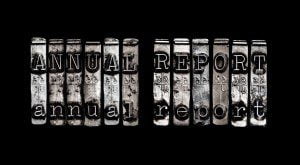An annual report is an important publication for communicating with shareholders, potential investors and the media. From experience editing and proofreading annual reports, we have come up with a list of points to keep in mind that will improve the content and effectiveness of your annual report.
Annual Report Editing Tip#1: Eliminate robotic writing.
By robotic writing we mean writing that’s impersonal, unnatural and too formal. For example, avoid referring to the company by constantly repeating the company name in the text. Instead use pronouns such as “we”, “us” and “our” in the annual report to create a more natural and conversational tone.
Here’s how one multinational company applied this in their annual report.
People Excellence: We’ve established a high-performance culture throughout our company. Based on clear performance goals, this culture enables our people to realize their full potential. To increase our global talent pool, we’re fostering talented young people worldwide. We’ve created new career tracks for experts and redesigned our management development program.
Notice how they also use contractions in this example (such as we’re and we’ve) which are effective for creating a friendly and conversational style. Forget your high school English teachers’ instructions to avoid using contractions in all writing. They are appropriate in many types of business writing, such as brochures, websites and other marketing formats.
For more information on avoiding robotic copywriting, and how to avoid it, read What Makes Copywriting Robotic?
Annual Report Editing Tip #2: Edit your annual report’s headings to keep them consistent.
This means choosing heading styles and applying them consistently. For example, if you use sentence case (capitalising the first word only) for a heading level, you will want to make this is consistent throughout the annual report. If the copy was originally written in Word and the heading styles were set up correctly, the fonts and point sizes should be consistent. However, consistency in capitalisation is often overlooked. This will also affect the table of contents, so you will also want to check that the headings are consistent in the table of contents as well. The following example shows part of a table of contents with inconsistent capitalisation:
Performance Highlights
Chief Executive Officer’s report
Corporate governance
Director’s Report
Annual Report Editing Tip #3: Check your annual report for correct capitalisation in the text.
One of the most common errors we find when editing any type of business publication is incorrect capitalisation. As a general rule, the first word of a sentence, proper nouns, titles and acronyms should be capitalised. For example:
“Acme Systems Pty Ltd specialises in the design and implementation of IT Security Systems” should be “Acme Systems Pty Ltd specialises in the design and implementation of IT security systems” (security systems is not a proper noun, so it should not be capitalised).
“Due to competition for talent within the Oil and Gas Sector, it’s imperative that our human capital solution maintains a strong people focus” should be “Due to competition for talent within the oil and gas sector, it’s imperative that your human capital solution maintains a strong people focus” (oil and gas sector is not a proper noun, so it should not be capitalised).
For a quick guide on capitalisation, go to http://www.monash.edu/about/editorialstyle/editing/capitalisation.
Annual Report Editing Tip #4: Edit your annual report to keep words and terminology consistent.
You can express words and phrases several ways. So when different people are writing parts of an annual report, they often use different spellings and styles. For example, one writer might write I.T. while another will write IT. Another example is how dates are expressed. One writer could express the date as June 30, 2015, while another could express it as 30 June 2015. Creating a style sheet and distributing it to the writers beforehand can help you avoid inconsistencies. Refer to the style sheet when editing and proofreading your annual report, and make changes to create consistency throughout the document.
Annual Report Editing Tip #5: Explain acronyms for readers who do not understand them.
If your annual report is going to a wide audience, it is likely that not all readers will understand the acronyms you use. So it’s a good idea to define acronyms in your annual report. When first introducing the term, spell it out and put the acronym in parentheses after the word. For example, “Eastern Industries uses several key performance indicators (KPIs) to track our progress over time.”
Annual Report Editing Tip #6: Keep your language as simple as possible and avoid long sentences.
Even if your annual report will be read by people with advanced reading skills, you will still want to make it as easy to read as possible. Avoiding long sentences and using the simplest words possible to convey your message are two steps for creating clear writing. If you find long sentences in your annual report, you can edit these into two sentences. For more details on simplifying your business writing, read Editing Your Business Writing to Make it More Readable.
By applying these simple tips when editing and proofreading your annual report, you will make it easier to read and more accessible to a larger audience.


